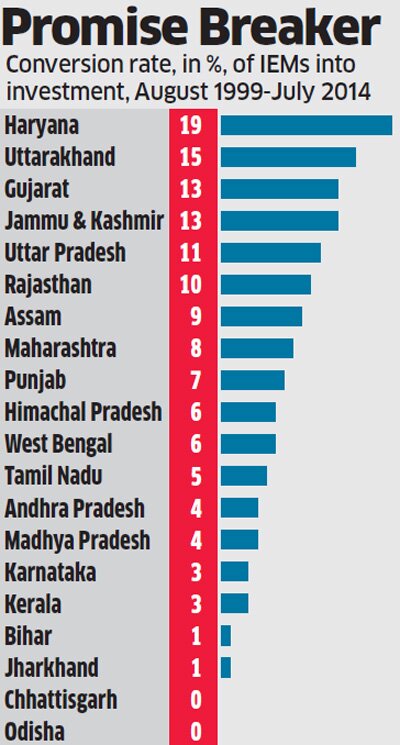The table provides a reality check. The highest rate of conversion is no more than 19 per cent, in Haryana, followed by Uttarakhand (15 per cent), Gujarat (13 per cent), Jammu and Kashmir (13 per cent), Uttar Pradesh (11 per cent) and Rajasthan (10 per cent). For Chhattisgarh and Odisha, the conversion is so low that it is not statistically different from zero. In Bihar and Jharkhand, it is just 1 per cent.
Industrial growth has been as fast in Maharashtra as in Gujarat, or faster. Yet, the conversion rate in Maharashtra has been only 8 per cent against 13 per cent in Gujarat. The big difference is that Maharashtra does not hold big investor jamborees. This suggests that whether investors invest or not has little to do with IEMs. Tamil Nadu has a conversion rate of only 5 per cent, although it is one of the top destinations of investment, and is widely praised by industrialists for its good investment climate.
On the other hand, Uttar Pradesh, which gets little actual investment, has a relatively high conversion rate of 11 per cent. If UP now holds investor summits, doubtless many more bogus IEMs will be signed, and the rate of conversion will fall drastically.
Gujarat has been holding investor summits every two years since 2003. The 2003 summit produced investment intentions of Rs 66,000 crore, and the sums have kept rising sharply to no less than Rs 25 lakh crore last week.
Impressed? Sorry, but Central Statistics Office data show that Gujarat’s entire GDP in 2012–13 was only Rs 6.7 lakh crore. Does anybody believe that investment can be several times the GDP? No. Businessmen simply dole out huge promises to lend fake prestige to a CM’s jamboree.
Lost in Conversation
Of course, investment intentions are not meant to fructify in just one year: Gujaratis say the new Rs 25 lakh crore will be spread over several years. But incredibly high investment pledges continue year after year. In 2009, when investment pledged was Rs 12.2 lakh crore, the state GDP was Rs 3.7 lakh crore. The 2011 jamboree drew pledges of Rs 20.1 lakh crore, when the state’s GDP was just Rs 5.2 lakh crore. Is it credible that year after year, Gujarat can attract almost four times its GDP? For a comparison, note that the national investment rate has been 30–38 per cent of GDP.
Hurray, I Scored 1 out of 100
Other state jamborees are no more credible. West Bengal is an industrial wasteland. Yet, when Mamata Banerjee held her summit earlier this month, she coolly declared, “Whatever happened in the past is not good. Forget about the past, and I am sorry for that.” Business politely obliged with pledges of Rs 2.3 lakh crore. She’ll be lucky if even 1 per cent of that fructifies.
Last year’s Madhya Pradesh investor summit, inaugurated by Modi and hence respected by businessmen, attracted pledges of Rs 6.7 lakh crore. This was more than the state’s entire GDP in 2013–14 of Rs 4.6 lakh crore! Punjab held a jamboree in December 2013 when the economy was in the doldrums and a hung Parliament looked likely. It attracted pledges of Rs 65,000 crore. This was less inflated a figure than for later jamborees. Yet, nobody takes that seriously.
Cynics will say it is silly to focus on the data. After all, everybody knows that jamborees are meant more to felicitate the CM than take hard investment decisions. I have no quarrel with that interpretation.

